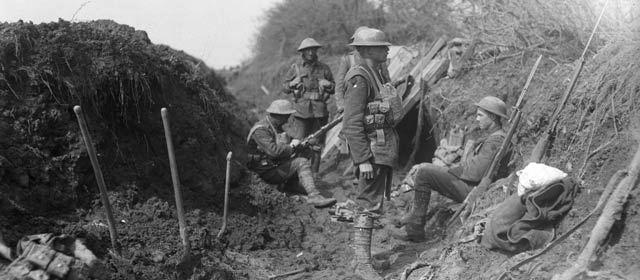Story summary
Origins
The First World War was caused by the destabilisation of the balance of power in Europe due to the rise of Germany. The war began in 1914 when Austria-Hungary invaded Serbia because of the assassination of an archduke. Countries had made alliances with each other, and soon most of Europe was at war.
New Zealand was part of the British Empire, and when Britain declared war on Germany, in August 1914, that meant New Zealand was at war too.
The two sides were called the Central Powers (Germany, Austria-Hungary) and the Allies, which included the British Empire, Russia and France.
New Zealand enters the war
New Zealand decided to send soldiers to fight in the war for a number of reasons, including New Zealand’s strong ties to Britain and its concern with keeping trade routes open so it could continue to export to Britain.
Within a month New Zealand troops had occupied Western Samoa, which was a German territory.
In October 1914 the first group of 8,454 soldiers left New Zealand heading for the other side of the world. Later a Māori contingent was sent.
At first the soldiers were volunteers, but later men were conscripted to fight.
Gallipoli
Turkey had entered the war on the side of the Central Powers. New Zealand and Australian (Anzac) troops supported British and French soldiers in an attempt to capture the Gallipoli Peninsula, in Turkey. Despite months of fighting, they were unsuccessful and many men died – about one in six of the New Zealand soldiers. Allied troops pulled out in January 1916.
The Western Front
Most of the New Zealand soldiers then went to northern France to fight on the Western Front, which stretched through France and Belgium. Each side had a line of trenches, and in between was a ‘no-man’s land’.
New Zealand troops were involved in many battles in France and Belgium. On 12 October 1917, in a battle at Passchendaele, New Zealand suffered its highest one-day death toll when 843 men were killed in just a few hours.
From August 1918 the Allies were able to push the German army back. The other Central Powers stopped fighting and on 11 November 1918 Germany accepted defeat. The war was finally over.
The home front
At first most public opinion was in favour of the war, but as it went on and more soldiers died, people became war-weary. Some men were conscientious objectors – they refused to fight in the war because of their beliefs – and some were punished for it.
Because so many men left to fight there was a shortage of workers, and so women stepped in to take jobs – though this was considered temporary.
Impact of the war
The loss for New Zealand was enormous – 5% of its military-age men died and many were wounded.
New Zealanders were proud of their country’s part in the war, and a sense of national identity had increased.
People commemorated the war by building memorials in towns throughout the country, and Anzac Day (25 April) became a day of remembrance for those who had died.





